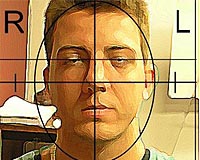 |
Washington DC (SPX) Nov 05, 2010 Move over, touchpad screens: New research funded in part by the National Institutes of Health shows that it is possible to manipulate complex visual images on a computer screen using only the mind. The study, published in Nature, found that when research subjects had their brains connected to a computer displaying two merged images, they could force the computer to display one of the images and discard the other. The signals transmitted from each subject's brain to the computer were derived from just a handful of brain cells. "The subjects were able to use their thoughts to override the images they saw on the computer screen," said the study's lead author, Itzhak Fried, M.D., Ph.D., a professor of neurosurgery at the University of California, Los Angeles. The study was funded in part by the National Institute of Neurological Disorders and Stroke (NINDS), and the National Institute of Mental Health (NIMH), both part of NIH. The study reflects progress in the development of brain-computer interfaces (BCIs), devices that allow people to control computers or other devices with their thoughts. BCIs hold promise for helping paralyzed individuals to communicate or control prosthetic limbs. But in this study, BCI technology was used mostly as a tool to understand how the brain processes information, and especially to understand how thoughts and decisions are shaped by the collective activity of single brain cells. "This is a novel and elegant use of a brain-computer interface to explore how the brain directs attention and makes choices," said Debra Babcock, M.D., Ph.D., a program director at NINDS. The study involved 12 people with epilepsy who had fine wires implanted in their brains to record seizure activity. Recordings like these are routinely used to locate areas of the brain that are responsible for seizures. In this study, the wires were inserted in the medial temporal lobe, a brain region important for memory and the ability to recognize complex images, including faces. While the recordings from their brains were transmitted to a computer, the research subjects viewed two pictures superimposed on a computer screen, each picture showing a familiar object, place, animal or person. They were told to select one image as a target and to focus their thoughts on it until that image was fully visible and the other image faded away. The monitor was updated every one-tenth of one second based on the input from the brain recordings. As a group, the subjects attempted this game nearly 900 times in total, and were able to force the monitor to display the target image in 70 percent of these attempts. Subjects tended to learn the task very quickly, and often were successful on the first try. The brain recordings and the input to the computer were based on the activity of just four cells in the temporal lobe. Prior research has shown that individual cells in this part of the brain respond preferentially - firing impulses at a higher rate - to specific images. For instance, one cell in the temporal lobe might respond to seeing a picture of Marilyn Monroe, while another might respond to Michael Jackson. Both were among the celebrity faces used in the study. Dr. Fried's team first identified four brain cells with preferences for celebrities or familiar objects, animals or landmarks, and then targeted the recording electrodes to those cells. The team found that when subjects played the image-switching game, their success appeared to depend on their ability to power up cells that preferred the target image and suppress cells that preferred the non-target image. "The remarkable aspects of this study are that we can concentrate our attention to make a choice by modulating so few brain cells and that we can learn to control those cells very quickly," said Dr. Babcock. Prior studies on BCIs have shown that it is possible to perform other tasks, such as controlling a computer cursor, with just a few brain cells. However, the task here was more complex and might have been expected to involve legions of cells in diverse brain areas needed for vision, attention, memory and decision-making. Reference: Cerf M et al. "On-line, voluntary control of human temporal lobe neurons," Nature, October 28, 2010.
Share This Article With Planet Earth
Related Links National Institute of Neurological Disorders and Stroke Space Technology News - Applications and Research
 Software Brings Facial-Recognition Technology To Mobile Phones
Software Brings Facial-Recognition Technology To Mobile PhonesManchester, UK (SPX) Nov 05, 2010 Scientists at The University of Manchester have developed software for mobile phones that can track your facial features in real-time. Eventually it will be able to tell who the user is, where they are looking and even how they are feeling. The method is believed to be unrivalled for speed and accuracy and could lead to facial recognition replacing passwords and PIN numbers to log into int ... read more |
|
| The content herein, unless otherwise known to be public domain, are Copyright 1995-2010 - SpaceDaily. AFP and UPI Wire Stories are copyright Agence France-Presse and United Press International. ESA Portal Reports are copyright European Space Agency. All NASA sourced material is public domain. Additional copyrights may apply in whole or part to other bona fide parties. Advertising does not imply endorsement,agreement or approval of any opinions, statements or information provided by SpaceDaily on any Web page published or hosted by SpaceDaily. Privacy Statement |